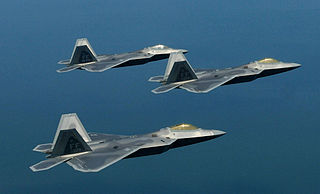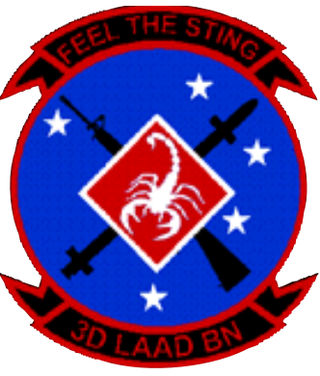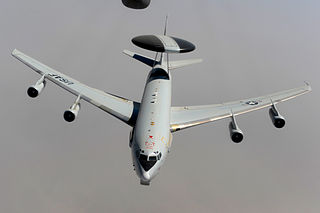
The Gulf War was an armed conflict between Iraq and a 42-country coalition led by the United States. The coalition's efforts against Iraq were carried out in two key phases: Operation Desert Shield, which marked the military buildup from August 1990 to January 1991; and Operation Desert Storm, which began with the aerial bombing campaign against Iraq on 17 January 1991 and came to a close with the American-led liberation of Kuwait on 28 February 1991.

The Iraqi no-fly zones conflict was a low-level conflict in the two no-fly zones (NFZs) in Iraq that were proclaimed by the United States, United Kingdom, and France after the Gulf War of 1991. The United States stated that the NFZs were intended to protect the ethnic Kurdish minority in northern Iraq and Shiite Muslims in the south. Iraqi aircraft were forbidden from flying inside the zones. The policy was enforced by the United States and the United Kingdom until 2003, when it was rendered obsolete by the 2003 invasion of Iraq. French aircraft patrols also participated until France withdrew in 1996.

The United States Central Command is one of the eleven unified combatant commands of the U.S. Department of Defense. It was established in 1983, taking over the previous responsibilities of the Rapid Deployment Joint Task Force (RDJTF).

The 1st Fighter Wing is a United States Air Force unit assigned to the Air Combat Command Fifteenth Air Force. It is stationed at Langley Air Force Base, VA. where it is a tenant unit, being supported by the 633d Air Base Wing.

The 11th Corps Signal Brigade of the United States Army is an element of Army Forces Command. It is based at Fort Cavazos, Texas. The unit mascot is the Thunderbird, a hawk-like bird perched upon a globe shooting thunderbolts out of its eyes. Soldiers in this unit call themselves "The Thunderbirds."

The Iraqi Armed Forces are the military forces of the Republic of Iraq. They consist of the Ground forces, the Army Aviation Command, the Iraqi Air Force, the Air Defence Command and the Iraqi Navy. The armed forces are administered by the Ministry of Defence (MoD). Effective control of the MOD armed forces rests with the Prime Minister of Iraq. Along with these primary service branches, there exists the Iraqi Counter Terrorism Service and the non-MOD paramilitary Popular Mobilization Forces.

Marine Wing Support Squadron 271 is an aviation ground support unit of the United States Marine Corps. They are based at Marine Corps Air Station Cherry Point, North Carolina. The squadron falls under the command of Marine Aircraft Group 14 and the 2nd Marine Aircraft Wing.

The Marine Wing Support Squadron 373 is an aviation ground support unit of the United States Marine Corps. They are based out of Marine Corps Air Station Miramar, California. The squadron is part of Marine Air Control Group 38 and the 3rd Marine Aircraft Wing.

The 60th Air Mobility Wing is the largest air mobility organization in the United States Air Force and is responsible for strategic airlift and air refueling missions around the world. It is the host unit at Travis Air Force Base in California. Wing activity is primarily focused on support in the Middle East region; however, it also maintains operations in areas of the Pacific and Indian Oceans.

The 11th Marine Expeditionary Unit is one of seven Marine Expeditionary Units currently in existence in the United States Marine Corps. The Marine Expeditionary Unit is a Marine Air Ground Task Force with a strength of about 2,200 personnel. The MEU consists of a command element, a reinforced infantry battalion, a composite helicopter squadron and a logistics combat element. The 11th MEU is currently based out of Marine Corps Base Camp Pendleton, California with headquarters in Camp Del Mar.

The 3d Low Altitude Air Defense Battalion is an air defense unit of the United States Marine Corps currently responsible for providing short range air defense. The battalion falls under the command of Marine Air Control Group 38 (MACG-38) and the 3rd Marine Aircraft Wing and is currently based at Marine Corps Base Camp Pendleton, California.

Operation Southern Watch was an air-centric military operation conducted by the United States Department of Defense from August 1992 to March 2003.

The 419th Fighter Wing is an Air Reserve Component (ARC) unit of the United States Air Force. It is assigned to the Tenth Air Force, Air Force Reserve Command, and is stationed at Hill Air Force Base, Utah.

The 552d Air Control Wing is an operational wing of the United States Air Force. It has been based at Tinker Air Force Base, Oklahoma, since July 1976, operating the Boeing E-3 Sentry. It includes the 552d Operations Group, 552d Maintenance Group, 552d Training Group, and 552d Air Control Group.

The 621st Contingency Response Wing is a United States Air Force rapid response expeditionary wing, based out of the McGuire Air Force Base entity of Joint Base McGuire-Dix-Lakehurst, New Jersey and Travis Air Force Base, California highly-specialized in training and rapidly deploying personnel globally to quickly open airfields and establish, expand, sustain, and coordinate air mobility operations during a variety of contingency operations.

Operation Vigilant Warrior was a military operation from 8 October 1994 to 15 December 1994 by the United States in response to two divisions of Iraqi Republican Guard troops moving toward the Kuwaiti border. A quick response by U.S. president Bill Clinton allowed USCENTAF command and staff to deploy to Riyadh within days.

Helicopter Sea Combat Squadron 25 (HSC-25) "Island Knights" is a United States Navy helicopter squadron based at Andersen Air Force Base, Guam. The "Island Knights" of HSC-25 fly the MH-60S "Knighthawk" helicopter, manufactured by Sikorsky Aircraft Corporation in Stratford, Connecticut.

Marine Wing Communications Squadron 38 (MWCS-38) is a United States Marine Corps communications squadron. The squadron provides expeditionary communications for the aviation combat element of the I Marine Expeditionary Force. They are based at Marine Corps Air Station Miramar, California, and fall under the command of Marine Air Control Group 38 and the 3rd Marine Aircraft Wing.

Airborne Command and Control Squadron 115 (VAW-115), also known as the "Liberty Bells", is a United States Navy airborne early warning and control squadron that flies the E-2D Advanced Hawkeye.

The United States Army Central, formerly the Third United States Army, commonly referred to as the Third Army and as ARCENT, is a military formation of the United States Army that saw service in World War I and World War II, in the 1991 Gulf War, and in the coalition occupation of Iraq. It is best known for its campaigns in World War II under the command of General George S. Patton.



















